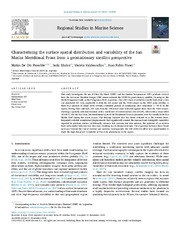Mostrar el registro sencillo del ítem
Characterizing the surface spatial distribution and variability of the San Matías Meridional Front from a geostationary satellite perspective
| dc.contributor.author | De Oto Proschle, Matías | |
| dc.contributor.author | Muñoz, Sofía | |
| dc.contributor.author | Valdeomillos, Violeta | |
| dc.contributor.author | Pisoni, Juan Pablo | |
| dc.date.accessioned | 2025-02-19T17:15:05Z | |
| dc.date.available | 2025-02-19T17:15:05Z | |
| dc.date.issued | 2025-01 | |
| dc.identifier.citation | Matias De Oto Proschle, Sofía Muñoz, Violeta Valdeomillos, Juan Pablo Pisoni, Characterizing the surface spatial distribution and variability of the San Matías Meridional Front from a geostationary satellite perspective, Regional Studies in Marine Science, Volume 81, 2025, 103920, ISSN 2352-4855, https://doi.org/10.1016/j.rsma.2024.103920. | es |
| dc.identifier.uri | http://hdl.handle.net/20.500.12160/2956 | |
| dc.description.abstract | This study investigates the use of Clear Sky Mask (CSKY) and Sea Surface Temperature (SST) products derived from the Advanced Baseline Imager (ABI) sensor onboard the GOES-16 geostationary satellite, focusing on the North Patagonian Gulfs on the Patagonian Shelf, Argentina. The CSKY mask is useful to identify both cloud cover and unreliable SST data, applicable to both the ABI sensor and the VIIRS sensor on the SNPP polar satellite. A three-year analysis of cloud cover revealed extended periods of continuous clear conditions (> 24 h) in the region. During these intervals, SST data from the ABI sensor were validated against those from the VIIRS sensor, showing a spatially coherent structure with a coefficient of determination (R2) of 0.99, albeit with a mean offset of 0.81°C. For the first time, the semidiurnal cycle of the Meridional Front is presented over the mouth of the San Matías Gulf during the warm season. Our findings indicate that this front, referred to as the western front, frequently exhibits semidiurnal displacements that significantly exceed the seasonal and fortnightly variability reported in previous studies. Additionally, towards late summer and into autumn, the presence of an eastern front with similar behavior was observed, resulting in a bi-frontal structure. The separation between these fronts increases towards the end of summer and autumn. Consequently, the ABI GOES-16 offers new opportunities to study the high-frequency variability of fine-scale phenomena in the region. | en |
| dc.description.abstract | Este estudio investiga el uso de los productos de Máscara de Cielo Despejado (CSKY, por sus siglas en inglés) y de Temperatura de la Superficie del Mar (SST, por sus siglas en inglés) derivados del sensor Advanced Baseline Imager (ABI) a bordo del satélite geoestacionario GOES-16, enfocándose en los golfos del norte de la Patagonia en la Plataforma Patagónica Norte, Argentina. La máscara CSKY es útil para identificar tanto la cobertura nubosa como datos no confiables de SST, siendo aplicable tanto al sensor ABI como al sensor VIIRS del satélite polar SNPP. Un análisis de tres años sobre la cobertura nubosa reveló períodos prolongados de condiciones despejadas continuas (> 24 h) en la región. Durante estos intervalos, los datos de SST del sensor ABI fueron validados frente a los datos del sensor VIIRS, mostrando una estructura espacialmente coherente con un coeficiente de determinación (R²) de 0.99, aunque con un sesgo medio de 0.81°C. Por primera vez, se presenta el ciclo semidiurno del Frente Meridional en la boca del Golfo San Matías durante la temporada cálida. Nuestros hallazgos indican que este frente, conocido como el frente occidental, exhibe con frecuencia desplazamientos semidiurnos que superan significativamente la variabilidad estacional y quincenal reportada en estudios previos. Además, hacia finales del verano y principios del otoño, se observó la presencia de un frente oriental con un comportamiento similar, resultando en una estructura bifrontal. La separación entre estos frentes aumenta hacia el final del verano y el otoño. En consecuencia, el ABI del GOES-16 ofrece nuevas oportunidades para estudiar la variabilidad de alta frecuencia de fenómenos de pequeña escala en la región. | es |
| dc.format | application/pdf | |
| dc.language.iso | eng | es |
| dc.publisher | Elsevier | es |
| dc.rights | info:eu-repo/semantics/openAccess | es |
| dc.rights | info:eu-repo/semantics/openAccess | es |
| dc.rights | © 2024 Elsevier B.V. All rights are reserved, including those for text and data mining, AI training, and similar technologies. | |
| dc.subject | Geostationary SST | es |
| dc.subject | SST Geoestacionaria | |
| dc.subject | Frentes de marea | |
| dc.subject | Variabilidad frontal | |
| dc.subject | Cobertura nubosa | |
| dc.subject | Golfo San Matías | |
| dc.title | Characterizing the surface spatial distribution and variability of the San Matías Meridional Front from a geostationary satellite perspective | es |
| dc.type | Artículo | es |
